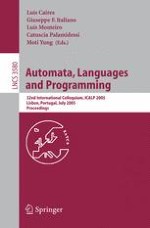The 32nd International Colloquium on Automata, Languages and Programming (ICALP 2005) was held in Lisbon, Portugal from July 11 to July 15, 2005. These proceedings contain all contributed papers presented at ICALP 2005, - getherwiththepapersbytheinvitedspeakersGiuseppeCastagna(ENS),Leonid Libkin (Toronto), John C. Mitchell (Stanford), Burkhard Monien (Paderborn), and Leslie Valiant (Harvard). The program had an additional invited lecture by Adi Shamir (Weizmann Institute) which does not appear in these proceedings. ICALP is a series of annual conferences of the European Association for Theoretical Computer Science (EATCS). The ?rst ICALP took place in 1972. This year, the ICALP program consisted of the established track A (focusing on algorithms, automata, complexity and games) and track B (focusing on logic, semantics and theory of programming), and innovated on the structure of its traditional scienti?c program with the inauguration of a new track C (focusing on security and cryptography foundation). In response to a call for papers, the Program Committee received 407 s- missions, 258 for track A, 75 for track B and 74 for track C. This is the highest number of submitted papers in the history of the ICALP conferences. The P- gram Committees selected 113 papers for inclusion in the scienti?c program. In particular, the Program Committee for track A selected 65 papers, the P- gram Committee for track B selected 24 papers, and the Program Committee for track C selected 24 papers. All the work of the Program Committees was done electronically.
